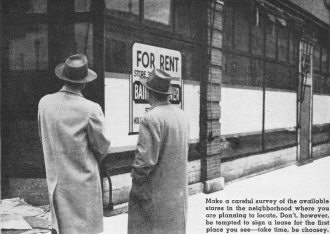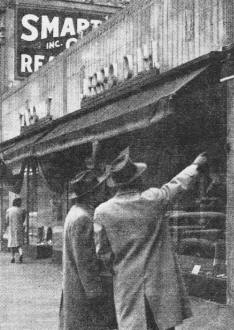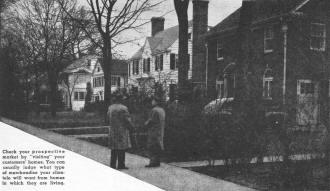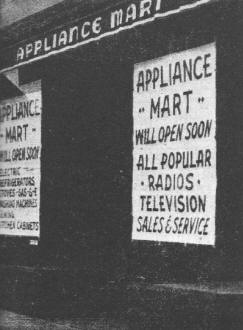|
April 1947 Radio News
 [Table of Contents] [Table of Contents]
Wax nostalgic about and learn from the history of early
electronics. See articles from
Radio & Television News, published 1919-1959. All copyrights hereby
acknowledged.
|
Location, location, and location.
Those are always half-jokingly cited as the three most important factors to consider
when deciding where to best set up a retail business. Unfortunately, the days of
scouting out a spot to set up an electronics sales and service shop are long gone.
Except for a cellphone screen replacement service at a mall kiosk and maybe the
Geek Squad desk at the Best Buy store, there are not many places
left that do consumer electronics repair - at least as a primary vocation. This
story makes a good read for anyone contemplating setting up shop where serving the
local population is a prime objective.
About two years ago, I visited a couple up-for-sale buildings being looked at
by daughter, Sally, for a business location. One building was a former TV and radio
repair shop that, I was told, had tons of old equipment removed from it just days
before I got there. I would have loved to been able to sift through the "garbage"
before it was all thrown away - what a waste!
The selection of a place in which to do business is the most important
decision the dealer must make.

Make a careful survey of the available
stores in the neighborhood where you are planning to locate. Don't, however, be
tempted to sign a lease for the first place you see - take time, be choosey.
By William L. Morris
Vice-President, Adams & Co., Real Estate, Inc., N.Y.C.
To any thoughtful man in the retail business the matter of the location of his
enterprise is of prime importance. He knows or at least senses that nothing can
make or break his venture as can his choice of location. It is as vital a matter
to the small retailer who is investing his savings, as it is to the chain store
organization and to the big individual investor in a retail business.
Chains and big retailers engage the services of store locating organizations,
whose experts gather data and advise. The small retailer may not be able to avail
himself of such a service; however, there is nothing to prevent him from observing
the principles that guide the procedure of store location for big corporations.
He can adopt the same principles, look for the same controlling factors, guard against
misjudgment in the same way as the large concern. How all of these elements are
to be applied is outlined in this discussion.
The consideration here is directed principally to the radio and appliance dealer
whose available financial means limit him to a comparatively low rental in his operational
budget. This discussion is concerned primarily with the radio and appliance dealer
whose budgeted rental is between $1200 and $2400 a year.

Try to visualize your store in the neighborhood shopping district.
The task of locating a store for his purpose, in the case of the radio and appliance
dealer of small means, is generally in his own hands, as the store location services
of a large real estate organization are not, as a rule, available to him. Such store
location services, which do so much of the work of spotting and evaluating locations
for chain stores and the larger independent retail establishments, are compensated
for the experience and expert facilities that they render by the brokerages on leases
and they make no charge to the lessee for whom the research is done. Since the expense
of this work is considerable, it is obvious that it can not usually be met by brokerages
on low-rental leases. For the dealer, however, whose projected rental is moderately
high the store location unit of a large and long-established real estate organization
provides him with expert service at no cost to himself.
The first consideration of the small radio and appliance dealer must be, as it
is with chains and large retailers and with the store location organizations that
render them service, to look to a retail section with established buying power.
This is fundamental. The section must be one to which people habitually come to
buy. Pioneering in an untested section is all very well for the man to whom pure
adventure in merchandising is the zest of life, but not for the man whose sole purpose,
aside from personal independence, is to provide an income for himself.
There happens to be, just now, a comparative scarcity of desirable retail locations,
so the task of finding a store with proper merchandising potentialities is a more
difficult one today than usual. It becomes doubly necessary, therefore, that the
radio and appliance dealer guard himself against taking "any old thing" out of sheer
discouragement. He must simply be more persistent in his search. A temptation in
the solution of his store-locating problem will be the new taxpayers in outlying
and newly developing residential neighborhoods which are bound to be one of the
answers in the new construction program, to the store location needs of the retail
trade generally. The dealer must keep in mind that, while a taxpayer property in
an old and established retail section presents a worthwhile location opportunity,
this is not necessarily true of a similar property in a newly initiated or "away-from-things"
zone, where no active buying has yet developed.
The radio and appliance business has a specific characteristic that weighs heavily
in the determination of store location, that is, that radios and appliances are
merchandise for home installation and home use (automobile radios are only a specialty).
That being the case, the retail section in which the radio and appliance store is
located must be one that serves a residential community. But it must be a sizeable
residential community. A small neighborhood that easily supports a grocer may very
well be too small to support a radio and appliance dealer, because, while people
eat every day, they do not buy radios or toasters or pressure cookers every day.

Check your prospective market by "visiting" your customers' homes.
You can usually judge what type of merchandise your clientele will want from homes
in which they ate living.
Generally, it is good sense for the prospective radio and appliance dealer to
look for a location in a section or along a street where house furnishings are already
being merchandised - a section containing stores selling furniture, draperies, linen
goods, kitchenware and other housewares. A concentration of such stores constitutes
a housewares shopping center to which housewives are accustomed to come for merchandise
for home installation and use. This principle, however, does not rule out sections
in which other types of stores are concentrated. It will frequently be found, for
instance, that stores merchandising women's apparel tend to group themselves along
a block or a couple of blocks. Now, quite obviously, there is no kinship between
women's apparel and radios and appliances. But the fact remains that, even in the
case of radios and appliances, and especially the latter, it is the woman of the
family who does the buying. And a radio and appliance establishment, standing out
by sheer contrast in a concentration of women's apparel shops, would have no inconsiderable
sales possibilities.
Real estate experts gauge location values by starting with what is known as "100
per-cent location" or "100 per-cent section." The evaluation of merchandising sites
is then graded down from that basis. A 100 per-cent section means simply the best
possible retail section in any given community. But contained within the definition
is a differentiation by type of business. In other words, the question of 100 per-cent
location is not only one of situation, but also of the kind of merchandise that
is sold by the store. A highly transient zone may be a 100 per-cent section generally
but not specifically for merchandise intended for home installation and use. Times
Square, in New York, is an example. Eating establishments, apparel stores, souvenir
stores belong there. A radio and appliance store does not. And there is none.
There is, of course, a 100 per-cent location for a radio and appliance store.
But that location will be one that serves a local or residential community. The
community may be a town with a surrounding rural area, like Poughkeepsie, N.Y.,
or a home locality in a large city, like Flatbush in New York City's borough of
Brooklyn. In Poughkeepsie, - and this observation holds true for hundreds of towns
throughout the country, - the 100 per-cent retail section is Main Street running
up and down from Market Street, the junction of these two arteries being the focal
point of the retail section. But at the same time that Main Street a few blocks
either Side of Market is the 100 per-cent section for stores generally, it is also
the 100 per-cent section for radio and appliance stores specifically. The reason
for that is that this retailing area serves the surrounding community, both urban
and rural, with all types of merchandise, including those for home installation
and use. In the same way, local communities within large cities have retail sections
which are 100 per-cent for those communities and these, like the Main Streets of
small cities and towns, are 100 per-cent sections not merely for merchandising in
general, but for sales of merchandise for home installation and use as well.
The 100 per-cent retail section in any given small town or local community tends
to be concentrated in from one to three blocks along the main artery. At both ends
of this section there is a tapering off of location value. At various points off
the 100 per-cent section running into the side streets, there are also very often
retail stores. These may run from a hundred to several hundred feet down the side
street or, in the case of an auxiliary artery crossing the main street, they may
run along for a block or two. It is at the end of the 100 per-cent section and on
the side streets immediately off it that the small radio and appliance dealer may
be able to find a store of the type that he needs and that is within range of his
finances. The question of the comparative merchandising value of the end-of-the-artery
location as against the off-the-artery location can be answered only by local conditions.
The subject of 100 per-cent location has been discussed here not because the
radio and appliance dealer of limited means is expected to achieve such a location,
for except under unusual circumstances, it is not likely. The 100 per-cent location
has been brought into the picture to provide him with the same basis for gaging
location values that is used by the experts of the store location services. The
100 per-cent location constitutes an ideal on which the small dealer should keep
his eyes even if he cannot attain the goal. He should try to get as close to this
ideal as he can within the limits of his financial means.

After visualizing your store, face the problem of whether a store
is needed.
In any retail center, from the 100 per-cent section down to the fairly good,
the determining factor in the rental figure is frontage, that is, the footage width
of store front. In fact, the real estate business itself always talks about stores
in terms of dollars-per-front-foot. The value per front-foot is itself determined
by the value of the location. The area of the store space is a secondary consideration
in these calculations, although it comes into play. For instance, in any good retailing
section, a 15' x 40' store (15' being the frontage) commands a higher rental than
11' x 100' store in the same section. The significance of frontage should not be
forgotten in any contemplation of store location, for it is a long established fact
that frontage, especially when the retailer utilizes his window space to its full
selling potentialities, is one of the strongest of merchandising factors. The radio
and appliance dealer would do well to sacrifice floor space to store frontage, as
far as the size of his inventory will permit. For the sake of frontage, even inventory
should be modified, if possible. Still, there are limits. For a radio and appliance
establishment, 13 to 14 feet of frontage would normally be considered the minimum.
In the same way, there is a minimum below which he should not go in the size of
his inventory. If he handles heavy-duty equipment, like ranges and refrigerators,
in addition to light-duty merchandise like toasters, and if he sells console-size
radios as well as table and other small models, his floor display requirements may
be such that he must content himself with small frontage in order to gain depth
and area. But that does not alter the principle; where possible, modify floor space
needs in favor of frontage.
It is not at all unusual to find that, in any retail center, one side of the
street is better than the other. What makes it better, among other things, is the
fact that it gets more pedestrian traffic or that it has a greater concentration
of the types of stores in which more people do their shopping. The better side of
the street invariably commands higher rentals. For the radio and appliance dealer,
the higher rental mayor may not be justified. If it happens for instance, that there
is a concentration of housewares stores on the less active side of the street, with
little or no competing radio and appliance business, that side might very well be
better for his purpose, at the same time saving him rent. If, on the other hand,
there is already a radio and appliance store on the less active side, the higher
rental on the better side might very well be justified.
In making evaluations of locations and in providing data from which his clients
make decisions, the store location expert adopts certain procedures, which are outlined
here. Nobody can expect the individual prospective radio and appliance dealer who
is out to spot a location of his own to adopt exactly the same procedures, but what
he can adopt and what he can keep in mind are the principles of those procedures.
He has much to gain in his own search for and decision on a location by coming as
close as he can, with his limited personal facilities, to the information a store
location service secures for its clients about any location under consideration.
In any event, it is well worth his while to take a glance at how a store leasing
expert goes about his business of compiling the background data needed for spotting
and evaluating a prospective location.
1. A compilation of the history of the retail section under consideration, including
information to date on ownership, rentals, lease expirations, zoning restrictions
and other pertinent data on all properties in the area. With this as a basis, the
individual site under consideration is then given attention as follows:
2. Complete details of the physical layout of the store as a basis for judging
its suitability, its advantages and its disadvantages for the particular business
involved.
3. Pedestrian traffic surveys which include (a) exact counts of passersby at
that spot, (b) checks on buyers and strollers in that retail section, (c) the source
and destination of traffic.
4. Studies of the retailing methods prevailing in the area.
Now, all this looks formidable and, in a sense, it is. And yet, in his own small
way, the prospective radio and appliance dealer can go a considerable distance in
the same direction.
First consider point No.1. For a store location expert, this entails a rather
extensive piece of research and the individual small dealer can not very well accomplish
that. But there are things he can do. He can drop in at the various shops in the
section (avoiding stores which handle merchandise with which his will be in competition),
say frankly that he is contemplating opening a radio and appliance store in the
area and ask questions. If they are well chosen questions, designed to provide him
with the type of information that will give him an over-all view of what has been
happening in the area, he will receive enough pertinent answers to provide him with
a reasonably good background.
Now look at point No.2, the store's layout. In this instance, the radio and appliance
dealer can do a considerable job for himself. As one example, he should take the
measurements not only of the floor dimensions, but also of the ceiling height, the
unbroken wall areas, the width and depth of window space, the degree of interference
of pillars, etc. This should be done before a lease is signed, not after, as is
often done. From these figures, he can then determine whether or not the space is
adequate for his projected inventory and suitable for the type of display and merchandising
procedure he has planned. He must keep in mind, however, that, while the store space
is fixed, there is nothing inflexible about either his planned inventory or his
merchandising procedure.
Item No.3 represents a type of re-search and an expenditure that is not within
the means of the small retailer. But even here he can make a number of moves of
his own. For one thing, by personal observation, he can get an approximate idea
of the extent of pedestrian traffic moving past a given location and how it is distributed
over the periods of the day. By observation again, he can get a fair idea of what
proportion of buyers enter the better-class retail establishments as against those
going into the low-priced stores.
Retailing methods, Item No.4, is again a broad study, but here, too, the small
dealer can do something for himself. He can go from store to store and determine
what class of merchandise is being handled in the immediate vicinity of his contemplated
location, how customers are handled, what the reactions of the customers are to
the type of merchandising that is now in effect in the vicinity.
This whole task of store location for the prospective radio and appliance dealer
becomes considerably easier if he has lived a long time in the community and has
become thoroughly familiar with its retail centers through long association. He
may already have absorbed over the years much of the knowledge that he might gain
by the procedures outlined. But, whether that is the case or not, the principles
outlined in this discussion still hold and the guides given remain valid.
Posted April 29, 2022
(updated from original post on 8/25/2016)
|













